Ultimate Load-Bearing Capacity and Sustainable Performance of Pile Foundations of Yanji Suspension Bridge in Fault Zone Based on Refined Geological Model
Abstract
:1. Introduction
2. Project Overview and Testing
2.1. Project Overview
2.2. Triaxial Compression Test on Mylonites
3. 3D Fine Geological Modelling
3.1. Introduction to the Multi-Platform Collaboration Method
3.2. The Steps for Fine Geological Modeling
- Open Goody software, determine the extent of the map using the drawing module according to the longitude and latitude of the project area.
- Enter the isoline extraction module and select the interval of sampling points and the distance of contour lines in the pop-up box to obtain the point cloud data and form an .asc file.
- Using the DSE module of CATIA software, import the .asc point cloud data and use the QSR model to form a terrain surface based on the point cloud and repair the surface.
- The hole position list, lithology data list, and inclination survey data list were sorted out according to the existing borehole column diagram and borehole location distribution data and imported into Surpac software to digitize the borehole location, lithology, and depth range.
- According to the distribution characteristics of the borehole location, a suitable interpretation section is established, the geological body area is delineated and derived according to the rock layer boundary for each interpretation section, and a closed section curve of the rock layer area is formed.
- Form the triangulation model by connecting the range curves of the strata formed by each section, and derive the WRL format for each lithological geological body.
- Enter the PD module of CATIA, seal the imported rock layers to obtain solid geological information based on the closed surface, and export it in stp or CATPart format.
- Import the file exported in the previous step into ABAQUS software for numerical finite element analysis.
3.3. Regional Geological Model of Pile Foundation Fault Zone
4. Results and Discussion
4.1. Stress Analysis of Pile Foundation and Surrounding Rock under Design Load
4.2. Load Analysis of Pile Foundation and Surrounding Rock under Overload Conditions
4.3. Ultimate Load-Bearing Capacity of a Pile Foundation under Overload Conditions
4.4. Sustainable Performance of the Pile Foundation
5. Conclusions
- (1)
- The triaxial compression test of the mylonites shows that mylonite at the bridge site can be simulated by the Mohr–Coulomb model.
- (2)
- Under the bridge design load, the shear stress concentration area of the pile body occurs mainly at the cap/pile body joint and the soft–hard rock interface, and the shear failure of the pile body can be prevented by appropriate reinforcement. The load stress of the pile foundation is transferred to the inside of the rock, and the stress increase of the hard limestone structure breccia is the most significant, and the stress influence area is about 40 m. The influence area of the soft mylonite at the pile bottom is about 25 m.
- (3)
- Under various bridge loads, the whole pile and the surrounding rock are basically under compression. As the load increases, the stress concentration area of the pile body gradually shifts upward from the pile bottom, and the compressive stress concentration area of the surrounding rock at the pile bottom increases. Under the condition of 4-times load, the maximum stress exists at the contact point between the pile body and the cap, and the local stress of the pile body may reach the strength of the pile concrete.
- (4)
- The plastic zone of the pile foundation is mainly concentrated at the bottom of the pile, and the area of the plastic zone gradually increases with the increase in load. When the bridge is subjected to 4-times design load, the surrounding rock at the bottom will become unstable and form an “X”-shaped shear failure zone, and the hard limestones in the fracture zone will not break and rotate relative to the soft mylonites.
- (5)
- After 100 years of operation, the pile is still under vertical pressure, and the maximum compressive stress reaches 28.6 MPa, which is 120% higher than that at the beginning of the bridge construction, but it is still lower than the compressive strength of concrete. The shear stress of the pile body increases significantly at the interface between the mylonites and the limestones, and the maximum shear stress reaches 3.6 MPa, which is 50% higher than that at the beginning of bridge construction.
Author Contributions
Funding
Institutional Review Board Statement
Informed Consent Statement
Data Availability Statement
Conflicts of Interest
References
- Lu, X.L.; Wei, K.; He, H.F.; Qin, S.Q. Life-cycle seismic fragility of a cable-stayed bridge considering chloride-induced corrosion. Earthq. Eng. Resil. 2022, 1, 60–72. [Google Scholar] [CrossRef]
- Zhang, Y.Y.; Ding, Y.; Pang, Y.T. Selection of optimal intensity measures in seismic damage analysis of cable-stayed bridges subjected to far-fault ground motions. J. Earthq. Tsunami 2015, 9, 1550003. [Google Scholar] [CrossRef]
- Li, C.; Li, H.N.; Hao, H.; Bi, K.M.; Chen, B.K. Seismic fragility analyses of sea-crossing cable-stayed bridges subjected to multi-support ground motions on offshore sites. Eng. Struct. 2018, 165, 441–456. [Google Scholar] [CrossRef]
- Dong, Y.; Frangopol, D.M.; Saydam, D. Sustainability of highway bridge networks under seismic hazard. J. Earthq. Eng. 2014, 18, 41–66. [Google Scholar] [CrossRef]
- Sabatino, S.; Frangopol, D.M.; Dong, Y. Sustainability-informed maintenance optimization of highway bridges considering multi-attribute utility and risk attitude. Eng. Struct. 2015, 102, 310–321. [Google Scholar] [CrossRef]
- Qian, J.; Zheng, Y.; Dong, Y.; Wu, H.; Guo, H.; Zhang, J. Sustainability and resilience of steel–shape memory alloy reinforced concrete bridge under compound earthquakes and functional deterioration within entire life-cycle. Eng. Struct. 2022, 271, 114937. [Google Scholar] [CrossRef]
- Yang, S.; Mavroeidis, G.P. Bridges crossing fault rupture zones: A review. Soil Dyn. Earthq. Eng. 2018, 113, 545–571. [Google Scholar] [CrossRef]
- Goel, R.K.; Chopra, A.K. Role of shear keys in seismic behavior of bridges crossing fault-rupture zones. J. Bridge Eng. 2008, 13, 398–408. [Google Scholar] [CrossRef]
- Pang, Y.T.; Wei, K.; He, H.F.; Wang, W.X. Assessment of lifetime seismic resilience of a long-span cable-stayed bridge exposed to structural corrosion. Soil Dyn. Earthq. Eng. 2022, 157, 107275. [Google Scholar] [CrossRef]
- Feng, Z.J. Foundation Engineering in Special Areas; China Communications Press: Beijing, China, 2008. [Google Scholar]
- Wei, K.; Zhou, C.; Xu, B. Numerical Simulation of Wave Loads on Elevated Pile Cap of Pile Group Foundation for Sea-crossing Bridges. Appl. Ocean Res. 2022, 125, 103245. [Google Scholar] [CrossRef]
- Jia, H.Y.; Yang, J.; Zheng, S.X.; Zhao, C.H.; Du, X.L. Review on seismic resistance of cross-fault bridges. J. Southwest Jiaotong Univ. 2021, 56, 1075–1093. [Google Scholar]
- Zhang, J.R.; Wei, K.; Pang, Y.T.; Zhang, M.; Qin, S. Numerical investigation into hydrodynamic effects on the seismic response of complex hollow bridge pier submerged in reservoir: Case study. J. Bridge Eng. 2019, 24, 05018016. [Google Scholar] [CrossRef]
- Bachinilla, B.; Evangelista, A.; Siddhpura, M.; Haddad, A.N.; da Costa, B.B.F. High-Speed Railway Bridge and Pile Foundation: A Review. Infrastructures 2022, 7, 154. [Google Scholar] [CrossRef]
- Bray, J.D. Designing buildings to accommodate earthquake surface fault rupture. In Proceedings of the ATC & SEI Conference on Improving the Seismic Performance of Existing Buildings and Other Structures, San Francisco, CA, USA, 9–11 December 2009; pp. 1–12. [Google Scholar]
- Park, S.W.; Ghasemi, H.; Shen, J. Simulation of the seismic performance of the Bolu viaduct subjected to near-fault ground motions. Earthq. Eng. Struct. Dyn. 2004, 33, 1249–1270. [Google Scholar] [CrossRef]
- Bransby, M.F.; Davies, M.; Nahas, A.E. Centrifuge modelling of normal fault foundation interaction. Bull. Earthq. Eng. 2008, 6, 585–605. [Google Scholar] [CrossRef]
- Zhao, M.H.; Liu, E.; Yang, J. Analysis of Stability of Pile Foundation with Higher Pile-column Bridge Piers. J. Highw. Transp. Res. Dev. (Engl. Ed.) 2009, 4, 40–44. [Google Scholar] [CrossRef]
- Ashour, M.; Abbas, A.I.; Boskovic, S. Pile Cap Interaction with Bridge Pile Foundations under Lateral Loads. J. Bridge Eng. 2019, 24, 04019053. [Google Scholar] [CrossRef]
- Zhang, X.Y.; Guan, J.D.; Chen, X.C.; Pei, W.; Yu, S.; Wang, Y.; Wang, W. Effect of Permafrost on Seismic Performance of Railway Bridge Pile Foundation with Elevated Cap. Int. J. Struct. Stab. Dyn. 2022, 22, 2241002. [Google Scholar] [CrossRef]
- Anastasopoulos, I.; Kourkoulis, R.; Gazetas, G.; Tsatsis, A. Interaction of piled foundation with a rupturing normal fault. Geotechnique 2013, 63, 1042–1059. [Google Scholar] [CrossRef]
- Dong, Y.X.; Feng, Z.J.; He, J.B.; Chen, H.Y.; Jiang, G.; Yin, H. Seismic Response of a Bridge Pile Foundation during a Shaking Table Test. Shock Vib. 2019, 2019, 9726013. [Google Scholar] [CrossRef]
- He, J.B.; Feng, Z.J.; Dong, Y.X.; Hu, H.B.; Liu, C.; Guo, S.Z.; Zhang, C.; Wu, M.; Wang, Z. Dynamic response of pile foundation under pile-soil-fault coupling in strong earthquake region. Rock Soil Mech. 2020, 41, 2389–2400. [Google Scholar]
- Hui, Y.X.; Wang, K.H. Study of seismic response characteristics of brides crossing faults. Bridge Constr. 2015, 45, 70–75. [Google Scholar]
- Feng, Z.J.; Guan, Y.H.; Zhang, C.; Meng, Y.Y.; Dong, Y.X. Study on dynamic response and avoidance distance of cross-fault bridge pile foundation in strong earthquake area. J. Chongqing Jiaotong Univ. (Nat. Sci.) 2022, 41, 72–80. [Google Scholar]
- Jia, P.; Wang, L.M.; Wan, Z.; Qiu, R.; Liu, J. Seismic calculation of a bridge pile foundation. China Earthq. Eng. J. 2018, 40, 258–264. [Google Scholar]
- Cai, Q.P.; Gan, G.L.; Wu, H.W.; Chen, X.; Xiao, Z. Study on failure mechanism and setback distance of a pile group in sand subjected to normal faulting. Rock Soil Mech. 2019, 40, 1067–1075+1128. [Google Scholar]
- Fu, W.J.; Xiao, C.Y.; Gan, G.L.; Chen, R.; Zhang, W. Numerical simulation of failure mechanism of high-rise pile cap foundation subject to normal fault. J. Huaqiao Univ. (Nat. Sci. Ed.) 2020, 41, 156–163. [Google Scholar]
- Feng, J.; Zhang, J.Y.; Zhu, M.; Jiang, N. Characteristic study of horizontal bearing capacity and pile group effect coefficient of laterally loaded high pile group foundation for bridge in soft soil. Rock Soil Mech. 2016, 37, 94–104. [Google Scholar]
- Song, R.B.; Qin, X.Q.; Tao, Y.Q.; Wang, X.Y.; Yin, B.; Wang, Y.; Li, W. A semi-automatic method for 3D modeling and visualizing complex geological bodies. Bull. Eng. Geol. Environ. 2019, 78, 1371–1383. [Google Scholar] [CrossRef]
- Hu, T.F.; Liu, J.K. Three-dimensional geologic modeling technology and stability analysis method of complex slope. J. Disaster Prev. Mitig. 2016, 36, 580–587. [Google Scholar]
- Liu, Y.F.; Hu, C.; Zhang, L.; Wang, W.M. 3D geological modeling based on GPR data and CATIA. Eng. J. Wuhan Univ. 2010, 43, 458–461. [Google Scholar]
- Su, X.N.; Wang, Y.; Han, X. Study on application of 3D geological modeling and visualization based on CATIA. Yangtze River 2015, 46, 101–104. [Google Scholar]
- Shalabi, F.I.; Saleem, M.U.; Qureshi, H.J.; Arifuzzaman, M.; Khan, K.; Rahman, M.M. Rahman. 3D FE analysis of bored pile- pile cap interaction in sandy soils under axial compression-parametric study. J. Eng. Res. 2023, 11, 301–313. [Google Scholar] [CrossRef]
- Chen, Y.; Yang, B.B.; Wei, S.; Dave, C. Numerical implementation method and it’s verification in ABQUS under the condition of periodical loading and unloading. J. Hydraul. Eng. 2014, 45, 67–72. [Google Scholar]
- Luo, S.L.; Huang, D.; Peng, J.B.; Ailifeila, A.; Li, Z.; Kuang, X.B.; Roberto, T. Performance and application of a novel drainage anti-slide pile on accumulation landslide with a chair-like deposit-bedrock interface in the Three Gorges Reservoir area, China. Comput. Geotech. 2023, 155, 105199. [Google Scholar] [CrossRef]

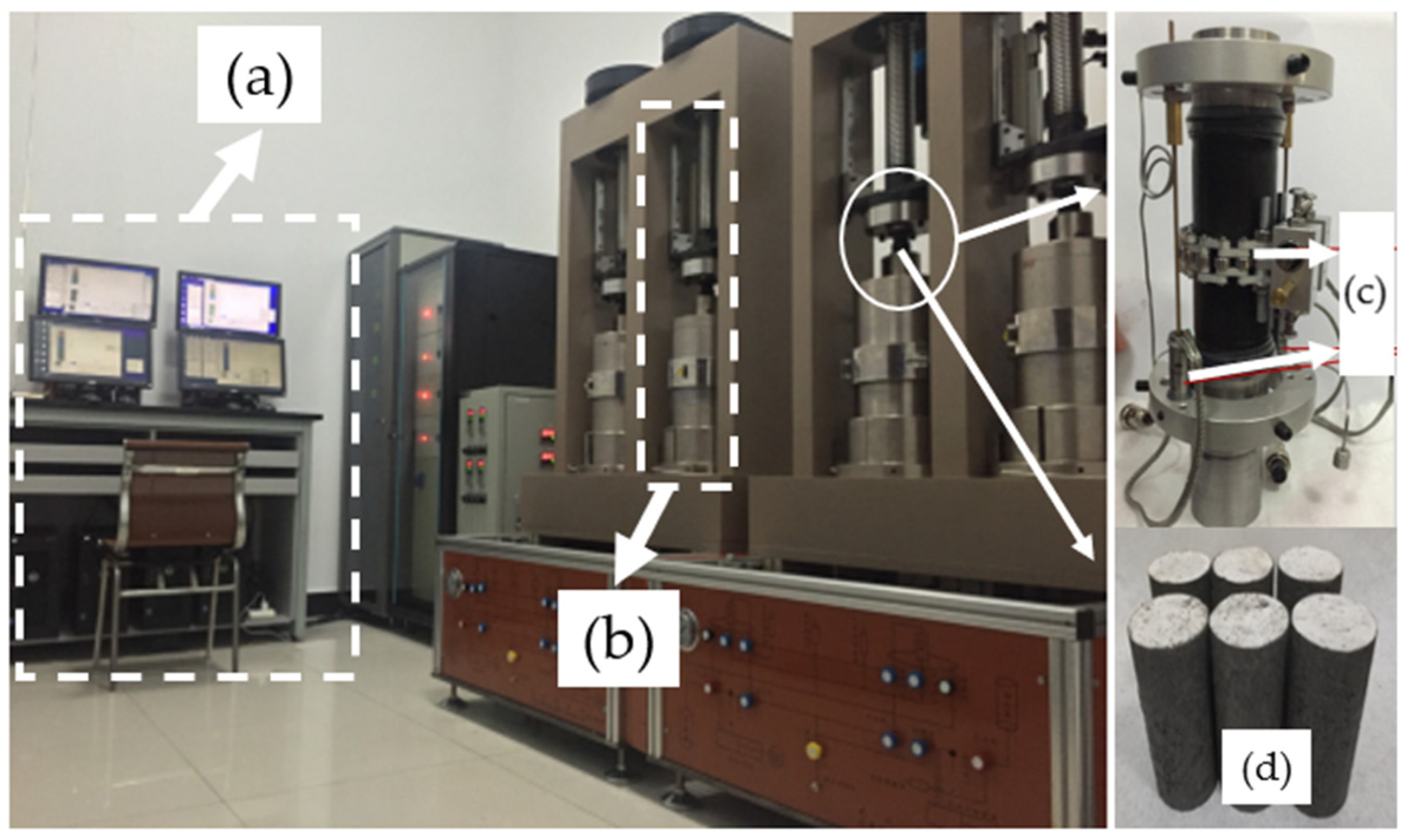
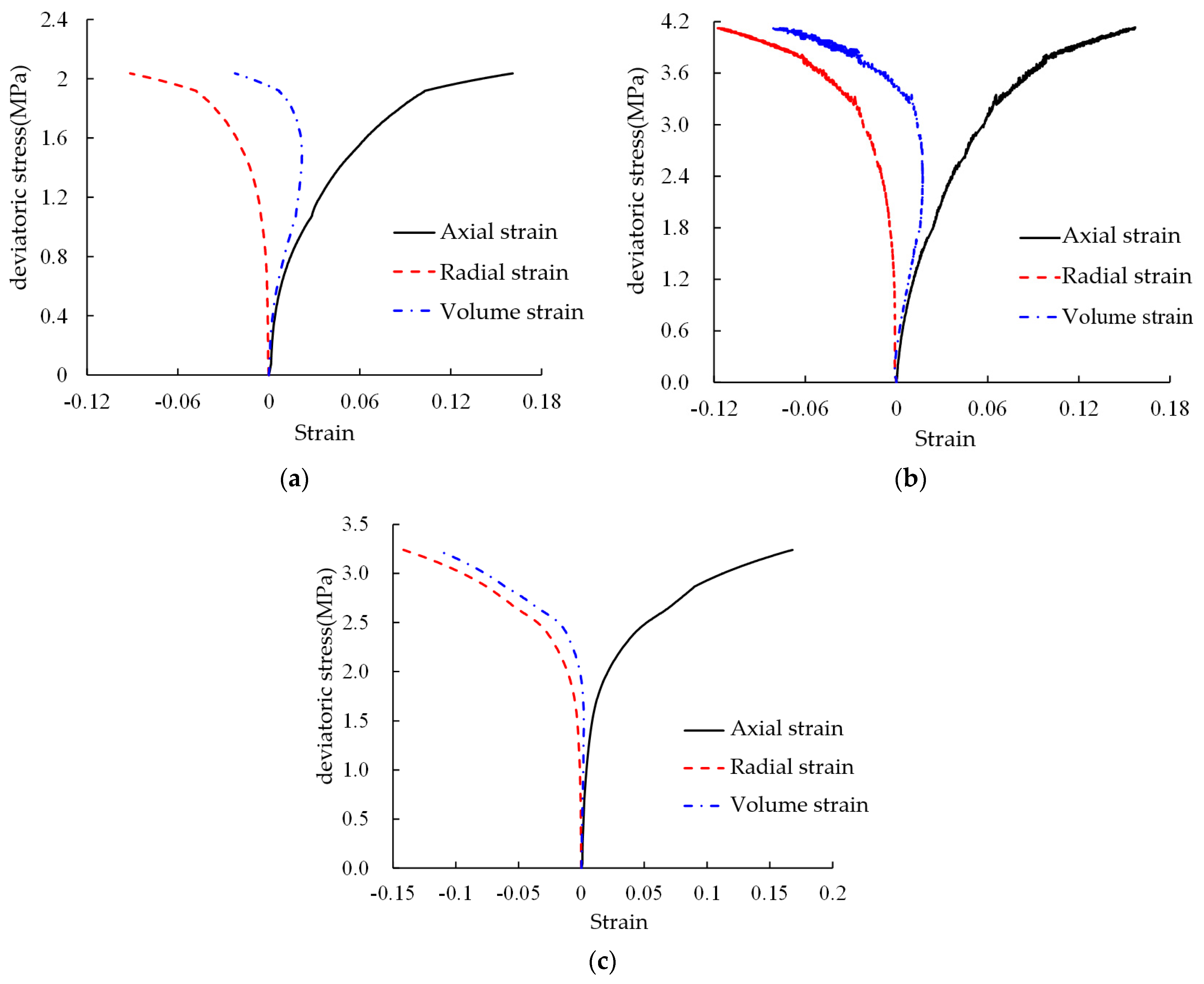

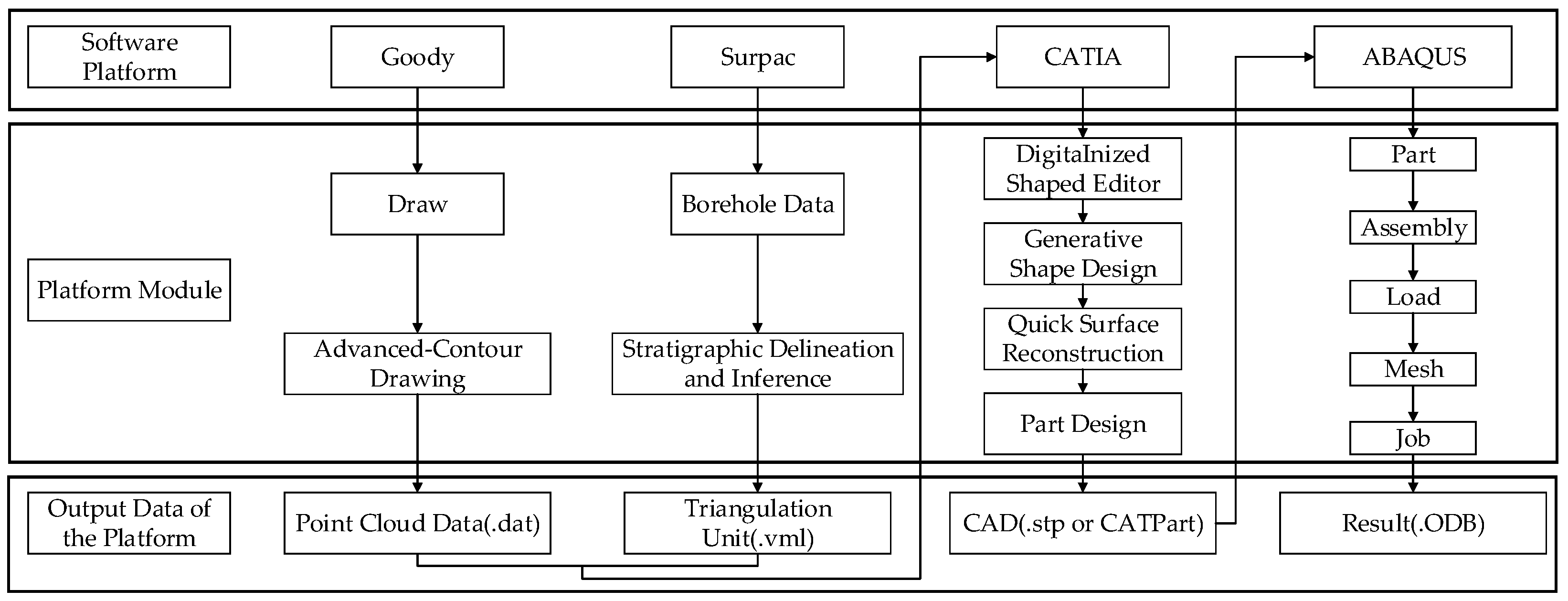
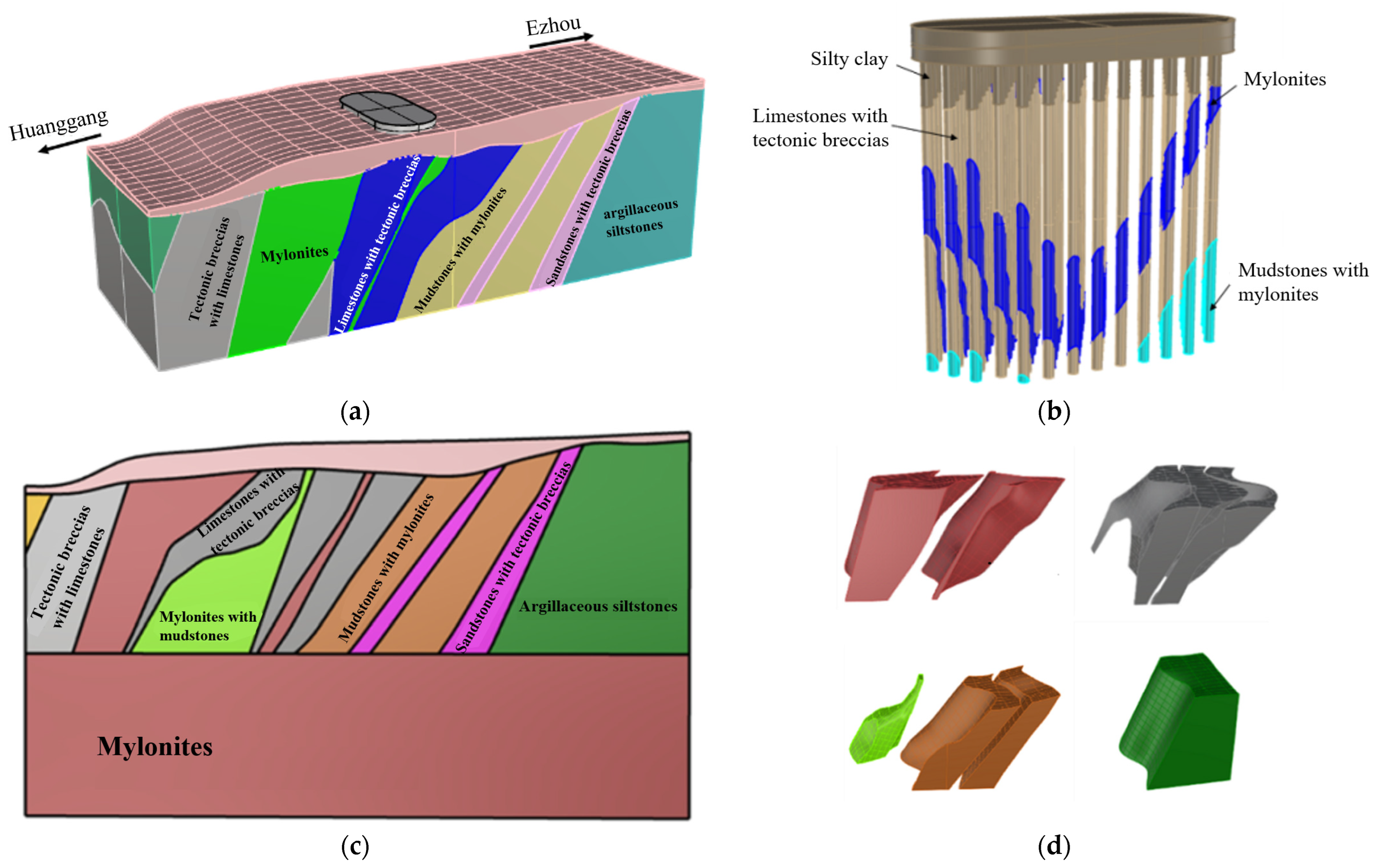

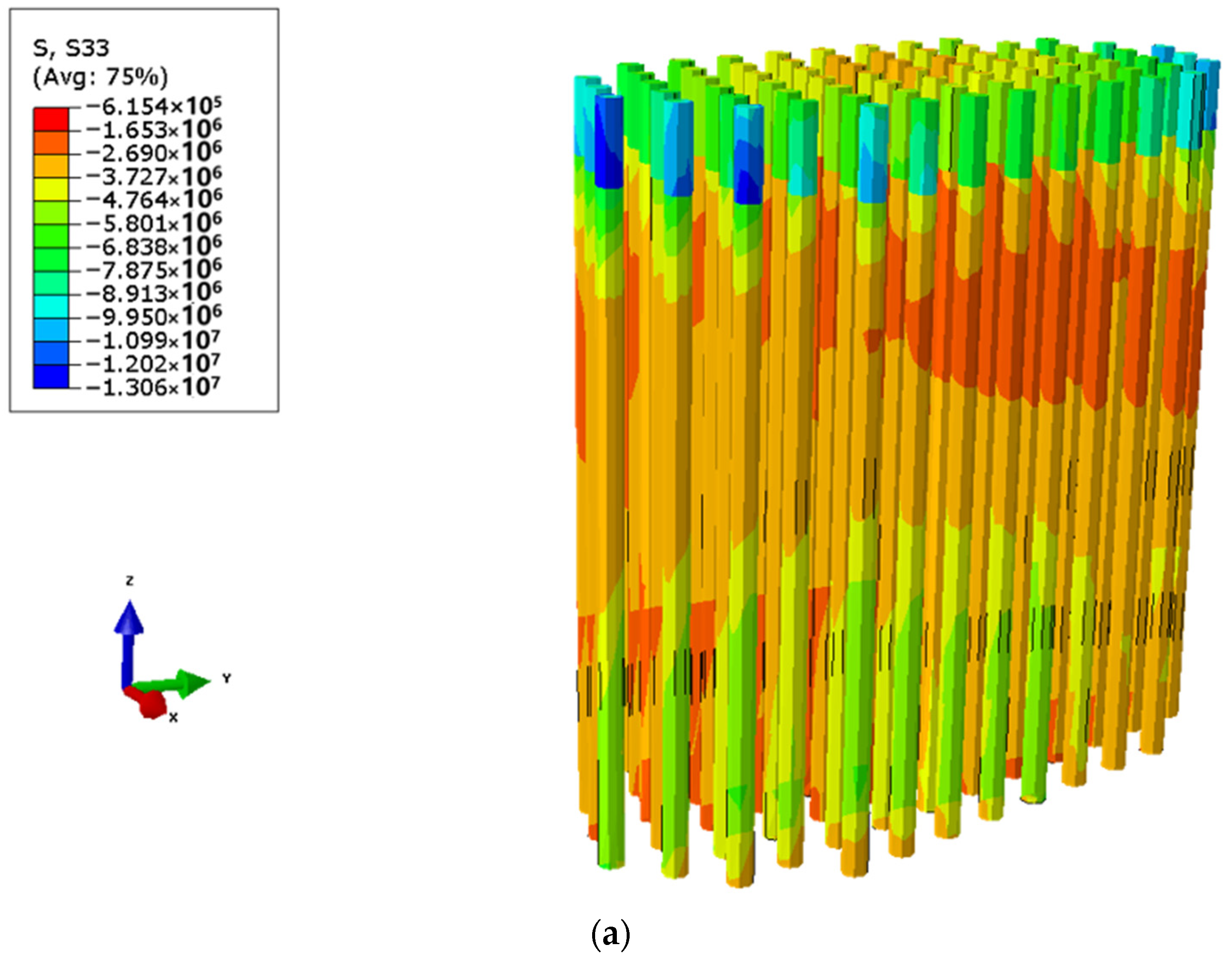


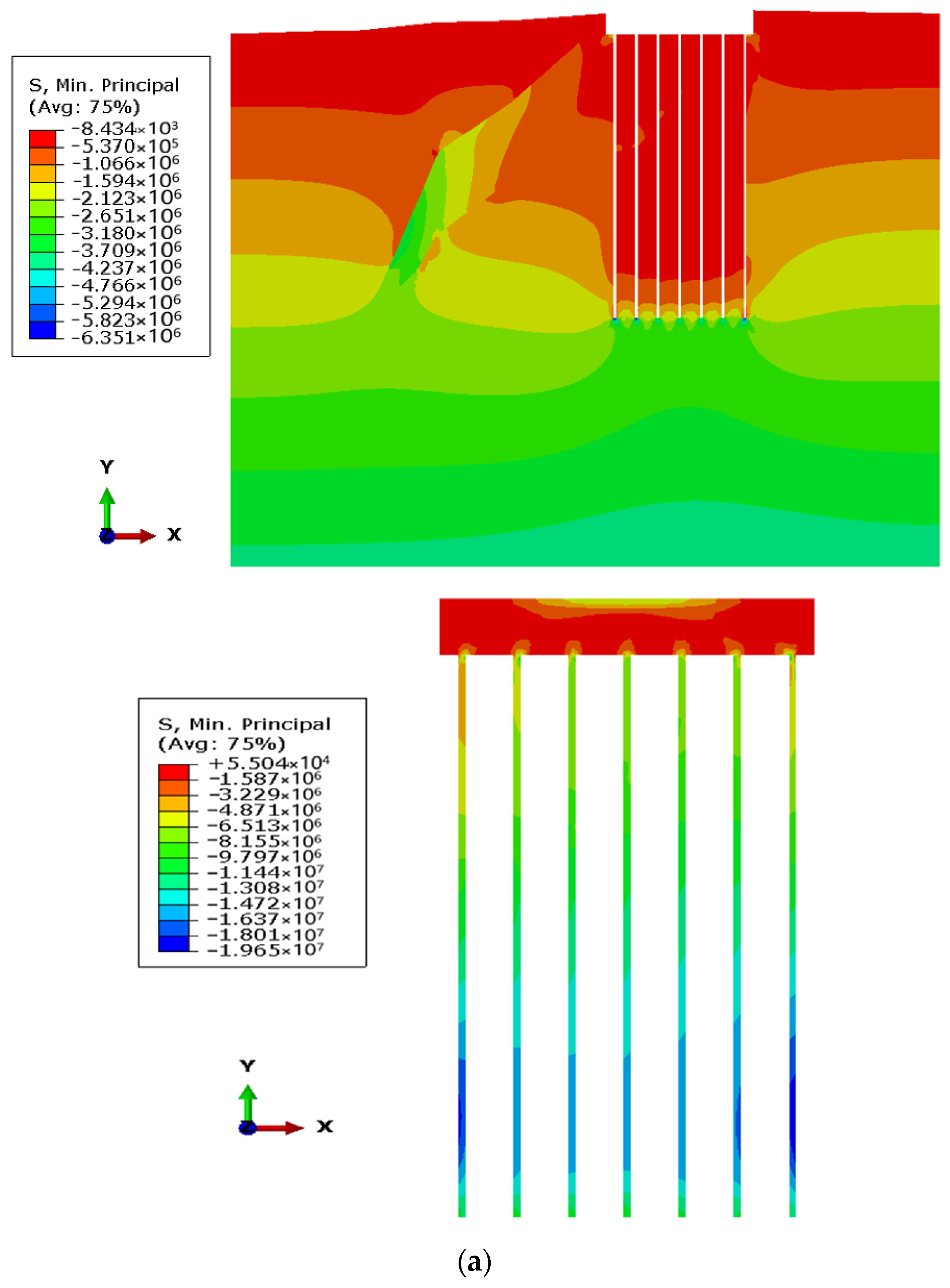

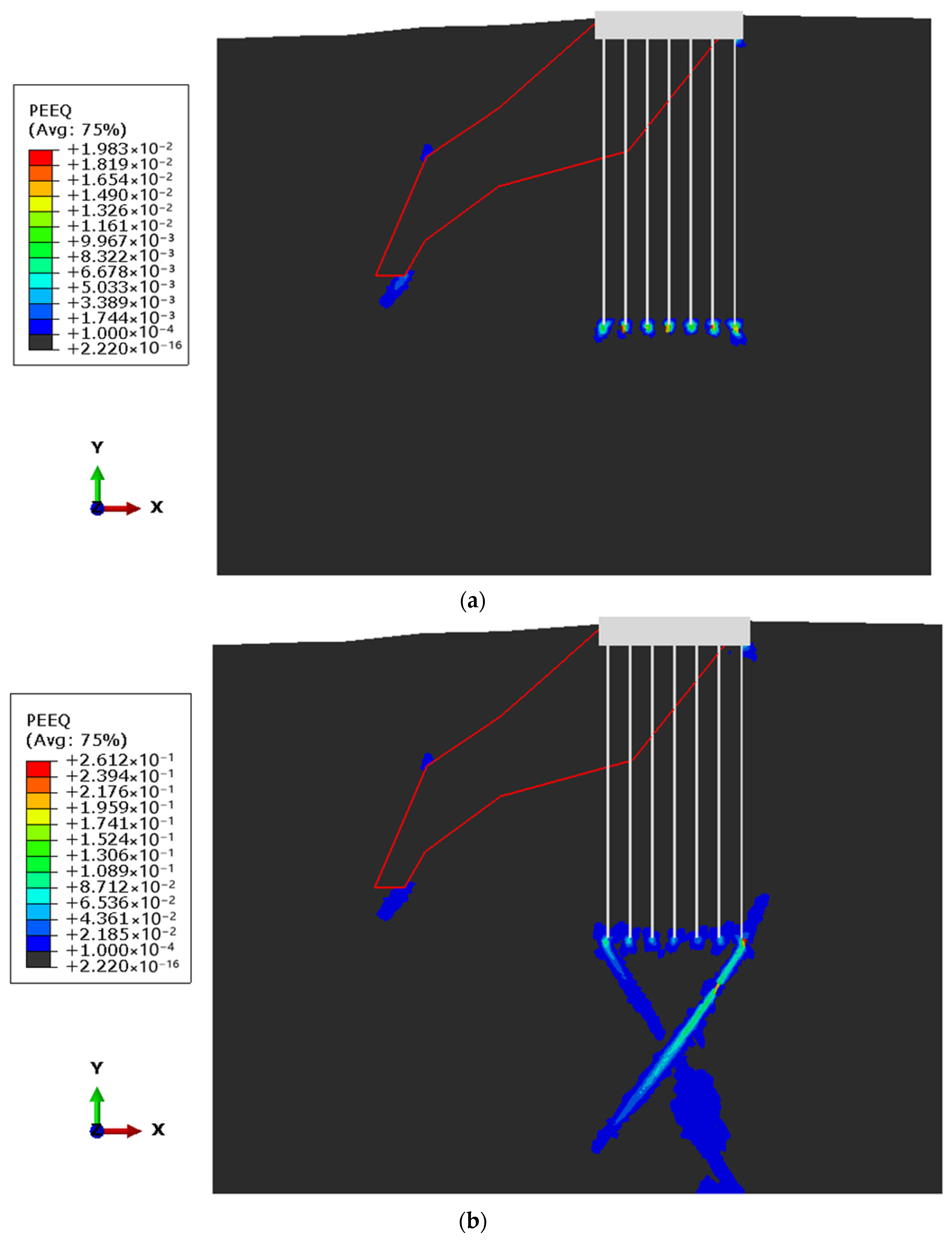
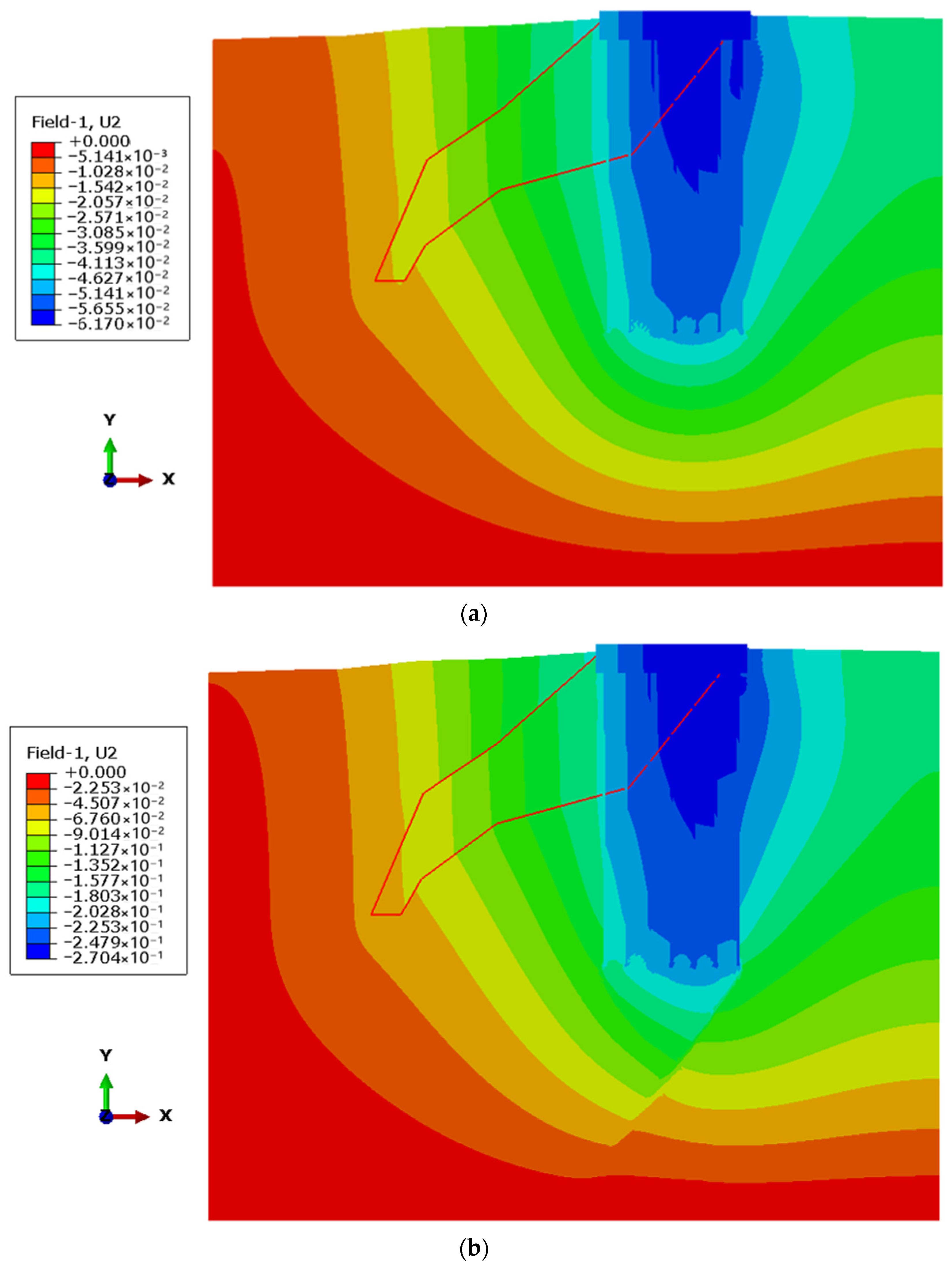

| Soil Layer | Natural Water Content w (%) | Density ρ (g·cm−3) | Natural Porosity e | Liquid Limit wL (%) | Plastic Limit wP (%) | Modulus of Compressibility Es0.1–0.2 (Mpa) | Uniaxial Compressive Strength f (Mpa) |
|---|---|---|---|---|---|---|---|
| ①1 silty clay | 29.8 | 1.9 | 0.840 | 37.18 | 22.61 | 5.60 | - |
| ①2 silty clay, silty soil interlayer | 30.6 | 1.9 | 0.870 | 32.28 | 21.01 | 4.13 | - |
| ①3 silty clay | 21.2 | 2.1 | 0.610 | 36.80 | 22.40 | 12.81 | - |
| ②3 intermediate weathered argillaceous siltstone | - | 2.6 | - | - | - | - | 30.87 |
| ③ mylonite | - | 2.4 | - | - | - | 140.63 | 0.92 |
| ④ tectonic breccia | 2.8 | 2.4 | - | - | - | 1346.15 | 5.14 |
| ⑤ limestone | 0.9 | 2.7 | - | - | - | 4711.54 | 48.10 |
| ⑥ mudstone | 2.4 | - | - | - | - | 802.47 | 2.22 |
| ⑦ calcareous sandstone | 2.5 | - | - | - | - | - | 27.55 |
| Sample Number | Modulus of Deformation (MPa) | Poisson Ratio | Confining Pressure (MPa) |
|---|---|---|---|
| S1 | 41.61 | 0.32 | 1 |
| S2 | 55.08 | 0.31 | |
| S3 | 72.42 | 0.33 | 2 |
| S4 | 142.42 | 0.30 | |
| S5 | 160.69 | 0.33 | 3 |
| S6 | 153.41 | 0.31 |
| Direction | Axial Force FN (kN) | Transverse Bending Moment Mz (kN·m) | Longitudinal Bending Moment My (kN·m) |
|---|---|---|---|
| Value | 2.43 × 106 | 5.38 × 106 | 2.44 × 106 |
Disclaimer/Publisher’s Note: The statements, opinions and data contained in all publications are solely those of the individual author(s) and contributor(s) and not of MDPI and/or the editor(s). MDPI and/or the editor(s) disclaim responsibility for any injury to people or property resulting from any ideas, methods, instructions or products referred to in the content. |
© 2024 by the authors. Licensee MDPI, Basel, Switzerland. This article is an open access article distributed under the terms and conditions of the Creative Commons Attribution (CC BY) license (https://creativecommons.org/licenses/by/4.0/).
Share and Cite
Ren, M.; Cheng, J.; Zhang, S.; Pang, Y.; Zhu, W. Ultimate Load-Bearing Capacity and Sustainable Performance of Pile Foundations of Yanji Suspension Bridge in Fault Zone Based on Refined Geological Model. Sustainability 2024, 16, 1858. https://doi.org/10.3390/su16051858
Ren M, Cheng J, Zhang S, Pang Y, Zhu W. Ultimate Load-Bearing Capacity and Sustainable Performance of Pile Foundations of Yanji Suspension Bridge in Fault Zone Based on Refined Geological Model. Sustainability. 2024; 16(5):1858. https://doi.org/10.3390/su16051858
Chicago/Turabian StyleRen, Meng, Jiaqi Cheng, Shengbin Zhang, Yutao Pang, and Weiyuan Zhu. 2024. "Ultimate Load-Bearing Capacity and Sustainable Performance of Pile Foundations of Yanji Suspension Bridge in Fault Zone Based on Refined Geological Model" Sustainability 16, no. 5: 1858. https://doi.org/10.3390/su16051858





